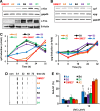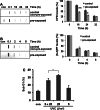Delayed c-Fos activation in human cells triggers XPF induction and an adaptive response to UVC-induced DNA damage and cytotoxicity
- PMID: 20976523
- PMCID: PMC3078315
- DOI: 10.1007/s00018-010-0546-9
Delayed c-Fos activation in human cells triggers XPF induction and an adaptive response to UVC-induced DNA damage and cytotoxicity
Abstract
The oncoprotein c-Fos has been commonly found differently expressed in cancer cells. Our previous work showed that mouse cells lacking the immediate-early gene c-fos are hypersensitive to ultraviolet (UVC) light. Here, we demonstrate that in human diploid fibroblasts UV-triggered induction of c-Fos protein is a delayed and long-lasting event. Sustained upregulation of c-Fos goes along with transcriptional stimulation of the NER gene xpf, which harbors an AP-1 binding site in the promoter. Data gained on c-Fos knockdown and c-Fos overexpressing human cells provide evidence that c-Fos/AP-1 stimulates upregulation of XPF, thereby increasing the cellular repair capacity protecting from UVC-induced DNA damage. When these cells are pre-exposed to a low non-toxic UVC dose and challenged with a subsequent high dose of UVC irradiation, they show accelerated repair of UVC-induced DNA adducts and reduced cell kill. The data indicate a protective role of c-Fos induction by triggering an adaptive response pathway.
Conflict of interest statement
The authors declare that there is no conflict of interest.
Figures








Similar articles
-
UV-Induced stabilization of c-fos and other short-lived mRNAs.Mol Cell Biol. 2000 May;20(10):3616-25. doi: 10.1128/MCB.20.10.3616-3625.2000. Mol Cell Biol. 2000. PMID: 10779351 Free PMC article.
-
c-Fos is required for excision repair of UV-light induced DNA lesions by triggering the re-synthesis of XPF.Nucleic Acids Res. 2006;34(22):6530-9. doi: 10.1093/nar/gkl895. Epub 2006 Nov 27. Nucleic Acids Res. 2006. PMID: 17130154 Free PMC article.
-
Primary mouse fibroblasts deficient for c-Fos, p53 or for both proteins are hypersensitive to UV light and alkylating agent-induced chromosomal breakage and apoptosis.Mutat Res. 2000 Dec 20;457(1-2):113-23. doi: 10.1016/s0027-5107(00)00133-0. Mutat Res. 2000. PMID: 11106803
-
Role of c-Fos in DNA damage repair.J Cell Physiol. 2024 May;239(5):e31216. doi: 10.1002/jcp.31216. Epub 2024 Feb 7. J Cell Physiol. 2024. PMID: 38327128 Review.
-
Recent research advances of c-fos in regulating cell senescence.Arch Biochem Biophys. 2025 Jul;769:110423. doi: 10.1016/j.abb.2025.110423. Epub 2025 Apr 15. Arch Biochem Biophys. 2025. PMID: 40246221 Review.
Cited by
-
Transcriptional regulation of human DNA repair genes following genotoxic stress: trigger mechanisms, inducible responses and genotoxic adaptation.Nucleic Acids Res. 2013 Oct;41(18):8403-20. doi: 10.1093/nar/gkt635. Epub 2013 Jul 27. Nucleic Acids Res. 2013. PMID: 23892398 Free PMC article. Review.
-
DNA damage and the balance between survival and death in cancer biology.Nat Rev Cancer. 2016 Jan;16(1):20-33. doi: 10.1038/nrc.2015.2. Epub 2015 Dec 18. Nat Rev Cancer. 2016. PMID: 26678314 Review.
-
Therapeutic targeting of ATR in alveolar rhabdomyosarcoma.Nat Commun. 2022 Jul 25;13(1):4297. doi: 10.1038/s41467-022-32023-7. Nat Commun. 2022. PMID: 35879366 Free PMC article.
-
Cdt2-mediated XPG degradation promotes gap-filling DNA synthesis in nucleotide excision repair.Cell Cycle. 2015;14(7):1103-15. doi: 10.4161/15384101.2014.973740. Cell Cycle. 2015. PMID: 25483071 Free PMC article.
-
Expression of XPG protein in the development, progression and prognosis of gastric cancer.PLoS One. 2014 Sep 30;9(9):e108704. doi: 10.1371/journal.pone.0108704. eCollection 2014. PLoS One. 2014. PMID: 25268735 Free PMC article.
References
-
- Christmann M, Fritz G, Kaina B (2007) Induction of DNA repair genes in mammalian cells in response to genotoxic stress. In: D. Lankenau (Ed) Genome dynamics and stability, vol 1. Springer, Berlin, pp 383–398
Publication types
MeSH terms
Substances
LinkOut - more resources
Full Text Sources
Molecular Biology Databases

